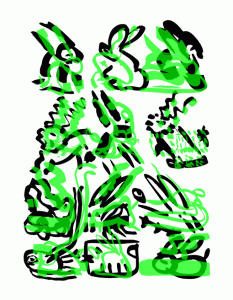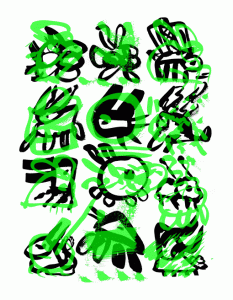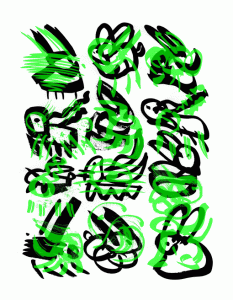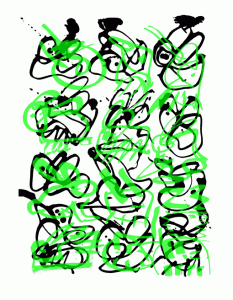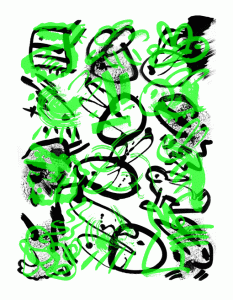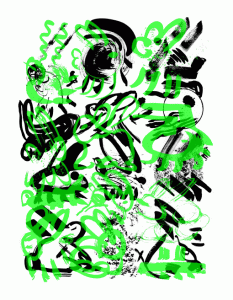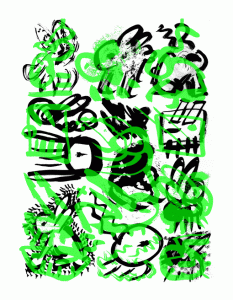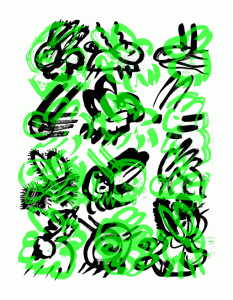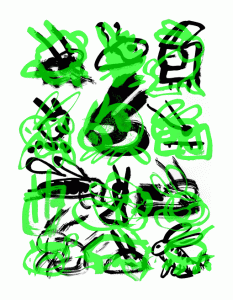Eduardo Kac: Lagoglyphs
- Jan 4, 2016
- 4 min read
Updated: Nov 27, 2024
Artwork series expands upon Kac’s controversial genetically altered Alba the GFP Bunny
The Lagoglyphs (2007-2009) series of artworks reference and expand upon Kac’s controversial genetically altered Alba the GFP Bunny (2000). The real-time animations, continuously flowing and reconfiguring themselves, place emphasis on the generative mutability of writing and the encoded nature of life.
Over the past three decades, Eduardo Kac has redefined avant-garde. Kac says,”This sense of inquiry upon the world…as well as the freedom to invent new ones—poetry and philosophy—they have been the wheel that has turned my practice…from the very beginning.” Read more
Lagoglyphs opened at the Streaming Museum on March 15, 2010, traveling to: Antarctica, Jubany and Marambia Scientific Bases of Argentina; Art Center Nabi, Seoul, Korea; Federation Square, Melbourne, Australia; 17 BBC Big Screens throughout the UK; Dubai 2011; Juilliard at Lincoln Center; Cocor MediaChannel, Bucharest, Romania; Utsikten Kunstenter, Kvinesdal, Norway; Chelsea Art Museum, NYC; Second Life, Greek Citystate of Colonia Nova; Google headquarters, NYC, the Big Screen Project in NYC.
To collect this work, write us at contact@streamingmuseum.org
LAGOGLYPHS ANIMATION
Price: $5,000 (US) for a double-disc. Contains the actual software that runs endlessly in real-time [Mac & PC] and a 6-min self-contained animation clip. Edition of 5 (signed, numbered, dated).
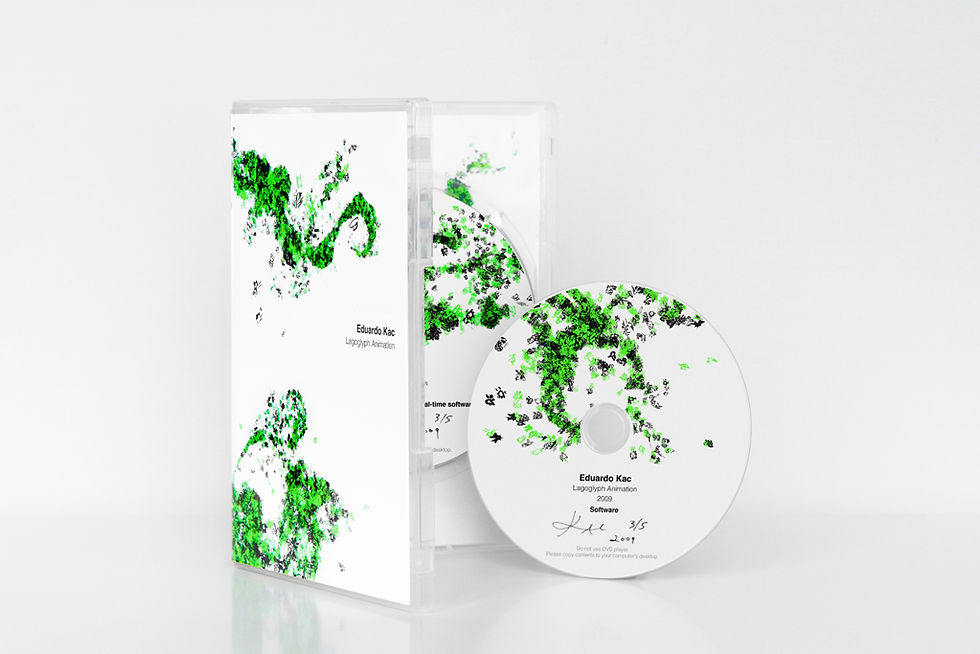

Lagoglyphs animation (2009) and Silk Screens at Enghien-les-Bains Art Center, France
Near left: Eduardo Kac, Lagoglyphs: Lagoogleglyph I (2009). Google Earth work composed of Lagoglyph installed on the roof of Oi Futuro, Rio de Janeiro, approx. 26 x 56 ft; and custom-ordered WorldView2 satellite photograph.
Eduardo Kac, Lagoglyphs, 2009, animation (excerpt)
LAGOGLYPHS SILKSCREENS

Instituto Valenciano de Arte Moderno (IVAM), Valencia, Spain
Lagoglyphs: The Bunny Variations
Limited Edition Silkscreens
15.5″ x 21.5″(40 x 54 cm) each
Lagoglyphs are a series of 12 bichrome silkscreens created by Kac in 2007 in which the artist develops a leporimorph or rabbitographic form of writing. As visual language that alludes to meaning but resists interpretation, the Lagoglyphs series stands as the counterpoint to the barrage of discourses generated through, with, and around Kac’s “GFP Bunny.”

Price: $ 500 (US) for each silkscreen (signed, numbered, dated). 12 different silkscreens, edition of 50. Available starting at number 21 (of 50).
Price: $5,000 (US) for the portfolio set of 12 with justification sheet. Available from numbers 1 through 20 (of 50). The portfolio is made of archival paper and includes an exclusive image on the cover not available in the prints.
Exhibition History of the complete set
1) Kunstverein Wolfsburg, Germany; “Work Fiction. Visions of labour in art, film and pop culture” (August 31 to November 4, 2007)
2) Instituto Valenciano de Arte Moderno (IVAM), Valencia, Spain, “Eduardo Kac” (September 27 to November 11, 2007)
3) Art Gallery of Alberta, Edmonton, “Imagining” (November 15, 2008-February 2, 2009)
4) Laznia Center for Contemporary Art, Gdansk, Poland, “Lagoglyphs” (January 15 to February 8, 2009)
5) Oi Futuro, Rio de Janeiro, Brazil, “Eduardo Kac: Lagoglyphs, Biotopes and Transgenic Works” (January 25th to March 30th, 2010)
6) Enghien-les-Bains Art Center, Enghien-les-Bains, France, “Life, Light & Language” (January 21th to April 10th, 2011) [with 100-page catalogue]
7) Black Box Gallery, Copenhagen, “Aromapoetry & Lagoglyphs” (May 17th to June 14, 2013)

EDUARDO KAC

Eduardo Kac was born in 1962, in Rio de Janeiro, Brazil. He lives and works in Chicago. Kac is a contemporary artist internationally recognized for his interactive net installations, telepresence and bio-art.
A pioneer of telecommunications art in the pre-Web ’80s, Eduardo Kac (pronounced “Katz”) emerged in the early ’90s with his radical works combining telerobotics and living organisms. His visionary integration of robotics, biology and networking explores the fluidity of subject positions in the post-digital world. His work deals with issues that range from the mythopoetics of online experience (Uirapuru) to the cultural impact of biotechnology (Genesis); from the changing condition of memory in the digital age (Time Capsule) to distributed collective agency (Teleporting an Unknown State); from the problematic notion of the “exotic” (Rara Avis) to the creation of life and evolution (GFP Bunny).
At the dawn of the twenty-first century Kac opened a new direction for contemporary art with his “transgenic art”–first with a groundbreaking piece entitled Genesis (1999), which included an “artist’s gene” he invented, and then with “GFP Bunny,” his fluorescent rabbit called Alba (2000).
Kac’s work has been exhibited internationally at venues such as Exit Art and Ronald Feldman Fine Arts, New York; Maison Européenne de la Photographie, Paris; Castello di Rivoli, Turin, Italy; Mori Art Museum, Tokyo; Reina Sofia Museum, Madrid; Zendai Museum of Modern Art, Shanghai; and Seoul Museum of Art, Korea. Kac’s work has been showcased in biennials such as Yokohama Triennial, Japan, Biennial of the End of the World, Ushuaia, Argentina, Gwangju Biennale, Korea, Bienal de Sao Paulo, Brazil, and International Triennial of New Media Art, National Art Museum of China, Beijing. His work is part of the permanent collection of the Victoria & Albert Museum, London, the Museum of Modern Art in New York, the Museum of Modern Art of Valencia, Spain, the ZKM Museum, Karlsruhe, Germany, and the Museum of Modern Art in Rio de Janeiro, among others.
His work has been featured both in contemporary art publications (Contemporary, Flash Art, Artforum, ARTnews, Kunstforum, Tema Celeste, Artpress, NY Arts Magazine), contemporary art books (Phaidon, Thames and Hudson, Oxford, MIT Press) and in the mass media (ABC, BBC, PBS, Le Monde, Boston Globe, Washington Post, Chicago Tribune, New York Times). Eduardo Kac has received many awards, including the Golden Nica Award, the most prestigious award in the field of media arts and the highest prize awarded by Ars Electronica. He lectures and publishes worldwide. ekac.org
To collect this work - contact@streamingmuseum.org


